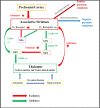Neurobiology of Schizophrenia: A Comprehensive Review
- PMID: 35541299
- PMCID: PMC9080788
- DOI: 10.7759/cureus.23959
Neurobiology of Schizophrenia: A Comprehensive Review
Abstract
Schizophrenia is a debilitating disease that presents with both positive and negative symptoms affecting cognition and emotions. Extensive studies have analyzed the different factors that contribute to the disorder. There is evidence of significant genetic etiology involving multiple genes such as dystrobrevin binding protein 1 (DTNBP1) and neuregulin 1 (NRG1). There is no clear link between neurotransmitter changes and the pathophysiology of schizophrenia; however, studies have shown that subcortical dopamine dysfunction is the key mechanism. Specific regions of gray and white matter changes are observed in patients with schizophrenia; gray matter changes being more significant after the onset of psychosis. These pathological changes may be implicated in the impairment of executive functioning, attention, and working memory. The disease can be managed with pharmacological treatments based on individual patient profile, patient compliance, and disease severity. The challenge of disease management sometimes persists due to the side effects. A better understanding of the pathological processes in schizophrenia may lead to more specific and effective therapies.
Keywords: dopamine; negative symptom; neurobiology; positive symptom; schizophrenia; serotonin.
Copyright © 2022, Luvsannyam et al.
Conflict of interest statement
The authors have declared that no competing interests exist.
Figures

References
-
- Global, regional, and national incidence, prevalence, and years lived with disability for 354 diseases and injuries for 195 countries and territories, 1990-2017: a systematic analysis for the Global Burden of Disease Study 2017. GBD 2017 Disease and Injury Incidence and Prevalence Collaborators. Lancet. 2018;392:1789–1858. - PMC - PubMed
-
- American Psychiatric Association. Arlington, VA: American Psychiatric Association; 2013. Diagnostic and statistical manual of mental disorders, fifth edition.
Publication types
LinkOut - more resources
Full Text Sources
Research Materials
